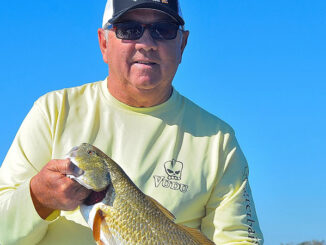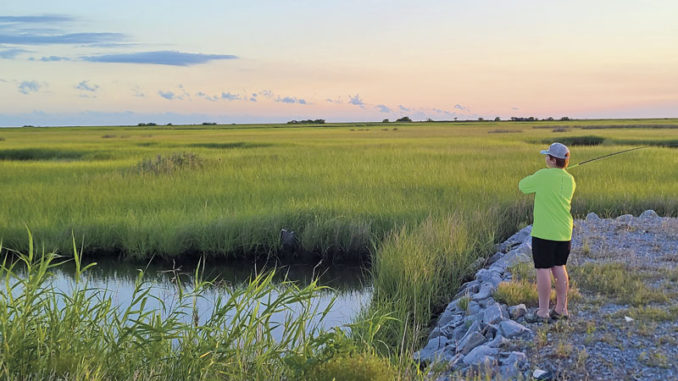
A glimpse at what makes Louisiana’s saltwater fishing the best!
Hollywood has its famed “Walk of Stars,” where legendary performers of the silver screen are commemorated with bronze stars.
Louisiana’s Gulf Coast has something similar. The entire coast is lined with special “stars.” Not bronze ones from the world of movies, but communities and fishing waters that are legendary stars of saltwater angling.
Renowned locations like Lake Pontchartrain, Shell Beach, Venice, Grand Isle, Golden Meadow, Leeville, Cocodrie, Barataria Bay and Calcasieu Lake are a huge part of Louisiana heritage and saltwater folklore, past and present.
In the following pages, we take a look at the entire coast from east to west to see what makes Louisiana’s coastal saltwater fishing the best!
From the Pearl River on the eastern border to the Sabine River deltas on the west, few states compare with the 400-mile-long Louisiana coast for its outstanding and renowned saltwater fishing action. Every angler likes to fish the old familiar waters, but when planning something different for your family vacation or just a weekend trip, consider the coast. The variety is endless. The scenery and history is amazing. And it’s the best fishing you’ve ever seen.
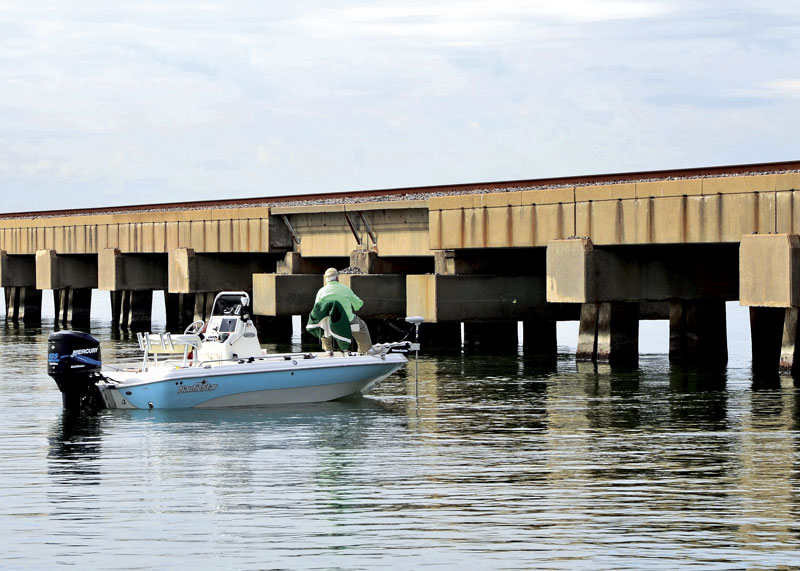
The realm of Pontchartrain
Bordering the most heavily populated region in the Sportsman’s Paradise, as well as virtually unpopulated wetlands, no waterbody so dominates southeastern Louisiana like Lake Pontchartrain. Really an estuary, Lake Pontchartrain formed about 5,000 years ago when the Mississippi River encircled a slice of the Gulf of Mexico.
Now, the Pontchartrain Basin covers more than 5,000 square miles, almost the size of Connecticut. The lake itself spreads across 630 square miles. It connects to Lake Borgne, really a bay off the gulf, through two deep passes, the Rigolets and Chef Menteur. To the west, two passes connect Lake Pontchartrain to Lake Maurepas, a mostly freshwater lake.
These lakes, passes, associated waters and surrounding marshes produce abundant fish of many species. Lake Pontchartrain delivered two Louisiana record book speckled trout. Another came from the Rigolets.
The Lake Pontchartrain Causeway, the longest bridge continuously over water in the world, measures 24 miles and spans the widest part of the massive lake. Anglers can also fish under Interstate 10, U.S. Highway 11 and an ancient railroad trestle. Highway and railroad bridges also cross the Chef and Rigolets. Every bridge provides excellent structure for fish.
“On Lake Pontchartrain, any bite could produce the new state record trout,” said Dudley Vandenborre, (985-847-1924) a guide from Slidell who tied for 10th place in the Louisiana record book with a 10.50-pound speck. “Over the years, I’ve had my best success fishing the railroad trestle along the south shore.”
West and East Pearl Rivers flow into the system, creating a lush delta wetland. Marshes between the Rigolets and Chef also produce numerous redfish, flounder and other species. At times, larger fish move from the gulf through these passes.
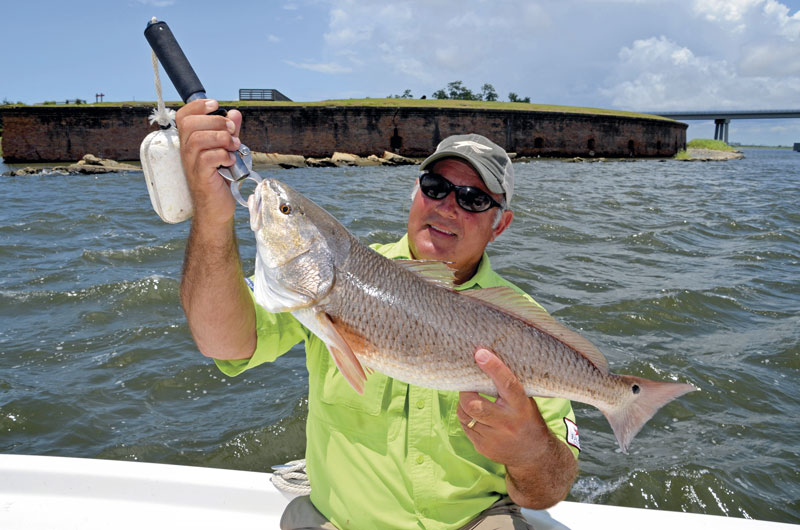
“The Pearl River Delta is a great area to fish for redfish, especially in the fall,” said Mike Gallo of Angling Adventures of Louisiana (877-4AAOFLA, www.aaofla.com) in Slidell. “When a front comes through, we can fish the bayous, jagged shorelines, ponds and marshy sloughs without going into open water in the lakes. The lakes can really get rough on short notice.”
Visitors find abundant lodging, restaurants and facilities in New Orleans and the Northshore communities of Madisonville, Mandeville and Slidell. Nautical aficionados might enjoy the Madisonville Wooden Boat Festival (www.louisiananorthshore.com/event/madisonville-wooden-boat-festival/472), held each fall on the Tchefuncte River. The festival celebrates the rich maritime history of the region with many hand-crafted wooden boats on display. Also check out the nearby Lake Pontchartrain Basin Maritime Museum (maritimemuseumlouisiana.org).
For information, call 800-634-9443 or see www.LouisianaNorthshore.com.
Bounty of Lake Borgne
Many people leave from Slidell and cross the 280-square-mile Lake Borgne to fish the vast marshes on the south shore. However, anglers can find closer marina facilities in Shell Beach, Hopedale and Delacroix.
From the south shoreline of Lake Borgne down to the eastern side of the Mississippi River at Pointe à La Hache, extensive marshes offer outstanding fishing for various species. In some places, anglers can catch redfish and largemouth bass in the same spots on the same lures on back-to-back casts. Fishermen can also head out from Hopedale to fish the Chandeleur Islands, a chain of barrier islands off the southeastern Louisiana coastline.
“The marshes south of Lake Borgne have always been good for fishing,” said Charlie Thomason with Bayou Charters (504-278-FISH, captaincharlie.com), who operates lodges in Hopedale. “We have so much marshland that anglers can find many places to get away from people. Sometimes, we go all day without seeing another fishing boat.”
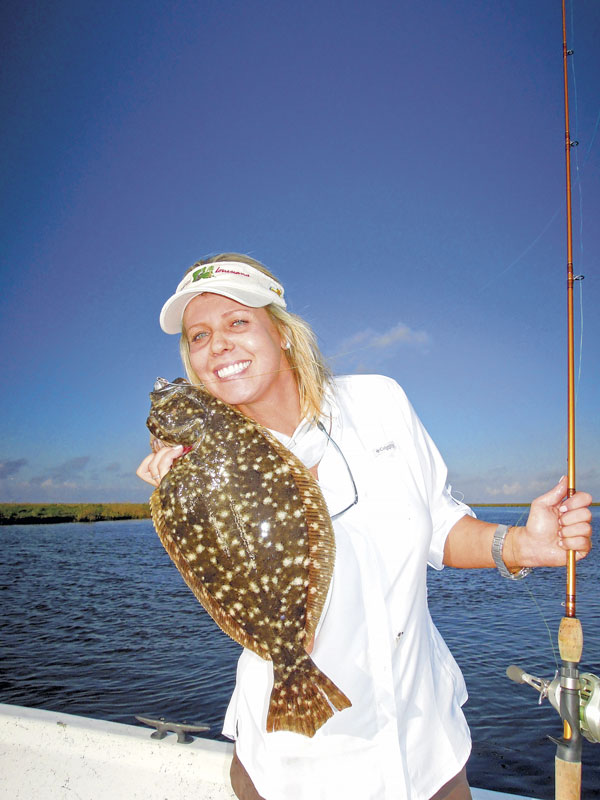
Some of the best redfish action in the nation occurs in the “Biloxi marshes” near Hopedale. Surrounding its namesake Bayou Biloxi, these marshes stretch across 120,000 acres with 35,644 acres conserved in the Biloxi Wildlife Management Area. Only reachable by boat, the pristine marsh contains numerous bayous and ponds full of fish. Also, bull reds patrol around grassy islands at the edge of Breton Sound. Kayakers launching at Hopedale Marina can fish the old Mississippi River Gulf Outlet, nicknamed “MRGO.” Some of the best fishing occurs near the dams, jetties and rocky shorelines.
Many visitors take a 40-minute drive from downtown New Orleans just to catch a glimpse of Louisiana culture with shrimp boats moored next to highways. Many pull off these highways to fish from the banks. Photographers might spot alligators, various birds and other wildlife.
The Katrina Memorial in Shell Beach is a stainless-steel cross memorializing 163 people from the area who died during that 2005 hurricane. Locals perform a memorial ceremony every Aug. 29, the anniversary of the killer storm.
“St. Bernard is an awesome place to visit,” Thomason said. “Many people just come down to see the area, stop and talk to local people. It’s a culture that people can’t find anywhere else in the country.”
Most guides operate full-service lodges for their customers. Some people rent out their camps. On your trip, pick up groceries and supplies in Chalmette or Violet. Several restaurants in those towns serve delicious food.
History buffs might want to tour the Chalmette Battlefield and National Cemetery. Here in 1815, General Andrew Jackson defeated a larger British force, saving New Orleans and propelling himself into the presidency. At West Pointe à La Hache, people can stay in the Woodland Plantation (www.woodlandplantation.com), which dates to 1834.
For information on St. Bernard Parish, call 504-278-4242 or see www.visitstbernard.com.
Mississippi River Delta mystique
The Mississippi River drains about 1.2 million square miles. All that water flows past Venice, creating and nourishing one of the most nutrient-rich and diverse wetlands in the world. And perhaps the world’s most famous fishing.
“The incredible Mississippi River Delta is unique because of that great river,” said Mike Frenette with Redfish Lodge of Louisiana (504-782-0924, Laredfish.com) in Venice. “No other place in the country has anything like it.”
From Venice Marina (venicemarina.com) or its neighbor, Cypress Cove, (www.cypresscovevenice.com), anglers can fish for anything that swims in Louisiana waters or the Gulf of Mexico. Theoretically, anglers could catch bluegills and blue marlin all in one day.
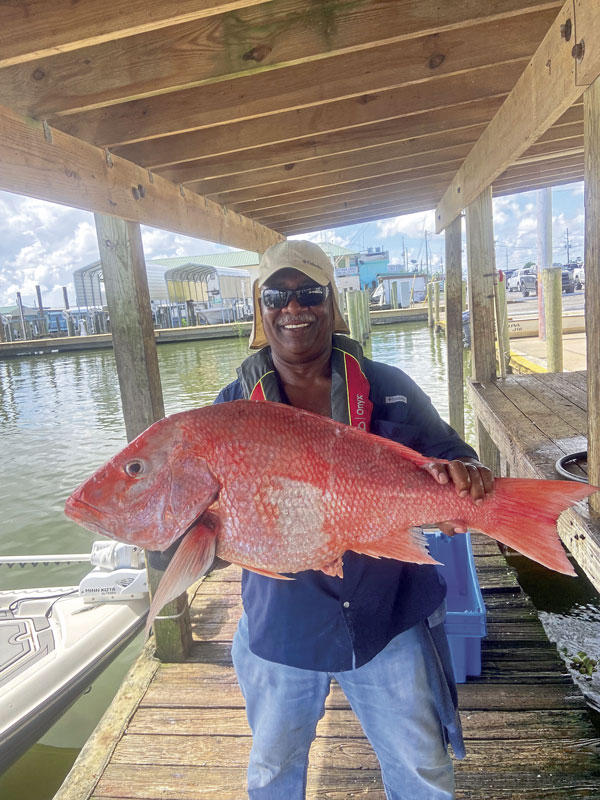
“Few places offer such varied fishing opportunities than the Mississippi Delta,” Frenette said. “It’s not unusual to go out into the gulf and fish for tuna, swordfish or marlin and then catch redfish, speckled trout, mangrove or red snapper on the way back. Anglers might also spot some tripletail, cobia or dolphin. I’ve had days when we’ve caught up to 17 different species.”
Salinity levels depend upon the river. During low water, people redfish in the Mississippi itself. Brown river water might gush through a drain, but anglers find salty water just outside the flow. Like chocolate icing on a mint cake, lighter fresh water “floats” on heavier, denser salt water. The surface might look brown, but a big redfish swishing its tail kicks up green water.
“In these marshes, we catch redfish 365 days a year,” Frenette said. “I’ve sight-cast to 30- to 40-pound reds. People can’t do that in many other places. In the fall of 2022, we had a great speckled trout run, probably the best I’ve seen in years.”
The river and storms periodically reconfigure the landscape, creating new sandbars or channels and tearing others apart almost overnight. Even people who know the area might get in trouble because things can change so quickly. Frenette highly recommends regulars fishing here buy a Louisiana One E-Card from Standard Mapping Services to put in GPS systems.
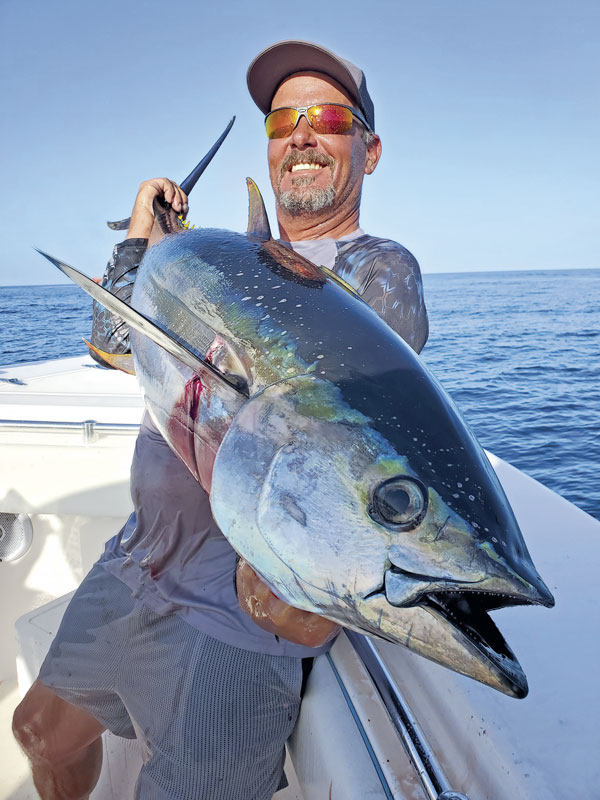
People call Venice “Tuna Town” because of the great offshore fishing in the gulf.
In recent years, swordfish became an angling target. Over eons, silt deposits pushed the river mouth almost to the continental shelf. The Mississippi Canyon elbows in toward the river, creating exceptional offshore and blue-water fishing after a short boat ride. A bucket list destination are the famous and productive Chandeleur Islands.
“Many big billfish tournaments run out of Venice,” Frenette said. “Some people run their boats all the way from the Florida Panhandle to fish off the Mississippi Delta.”
Venice visitors can stay and eat at the two marinas. Restaurants along Highway 23 serve great food. Anglers can also find lodging and facilities in Empire and Buras.
“The Mississippi Delta is a special place,” Frenette said. “For anyone who has never visited this area, Venice should be on any sportsman’s bucket list to visit.”
For Plaquemines Parish information, call 504-934-6000 or see www.plaqueminesparishtourism.com.
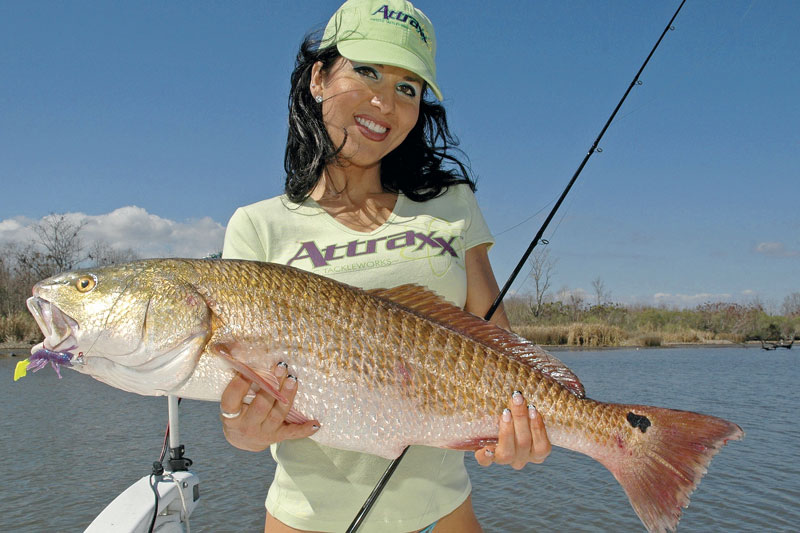
Grandness of Barataria
From Lake Salvador to the Gulf of Mexico and between the Mississippi River and Bayou Lafourche, the Barataria Estuary offers anglers some of the best saltwater fishing in North America. Mention fishing out of Grand Isle and there is no further explanation needed. Numerous marshy ponds also pockmark the area, creating superb redfish habitat. The entire estuary produces grand numbers of speckled trout and other species.
“We’re only 19 miles south of New Orleans,” said Theophile Bourgeois IV of Bourgeois Fishing Charters (504-341-5614; neworleansfishing.com) in Barataria. “We can see the city across the marshes when fishing. Just outside that metropolitan area, we have such a lush natural environment with so many fish, birds and animal species.”
No other place in coastal Louisiana more clearly defines “destination” than Grand Isle. The only occupied barrier island in the state separates Barataria Bay from the gulf along with its neighbor, Grand Terre. The pirate turned patriot Jean Lafitte once lived on Grand Terre. Now, the never-finished Civil War-era Fort Livingston sits on the site.
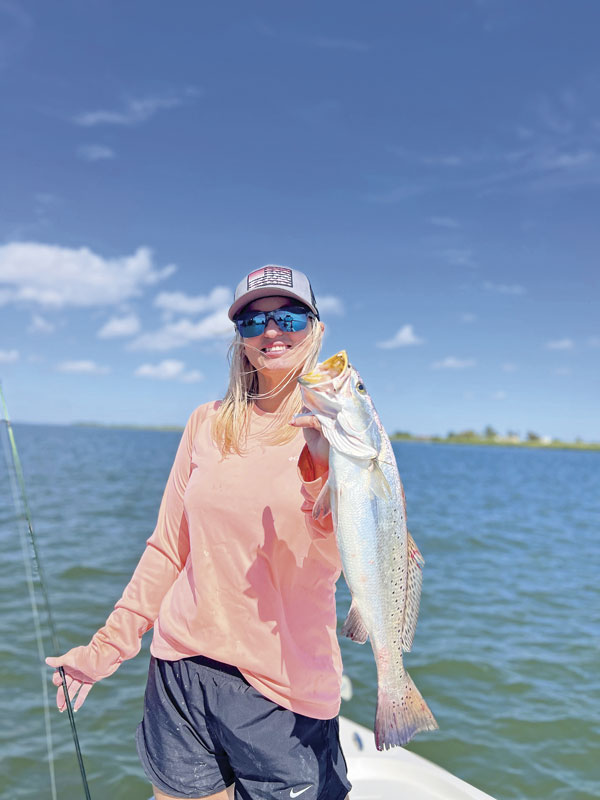
“For anyone looking for a family vacation destination or fishing opportunities on the Louisiana coast, there’s no other place like Grand Isle,” said Daryl Carpenter with Reel Screamers Guide Service (225-937-6288, www.reelscreamers.com). “Grand Isle offers something for the entire family.”
Grand Isle offers the only beach accessible by automobile in southeast Louisiana. Wade the beaches to fish or catch blue crabs. Anglers fish at various places along Highway 1.
“For fishing, this area is very versatile,” Carpenter said. “We have easy access to the Gulf and to the bays. For trout, redfish and other species, anglers don’t need to run far to find fish. In the summer, beach fishing turns hot. Many days, wade fishermen catch as many fish as we do in boats because we’re fishing right next to the beach. In May, we start seeing a lot of cobia.”
From Grand Isle, offshore anglers can reach deep waters quickly. From the island, boaters run about 35 to 40 miles to reach the Mississippi Canyon. The granddaddy of all Louisiana fishing events, the Grand Isle Tarpon rodeo runs every July, but many other events stage out of the island. Starting in May, some type of fishing event takes place practically every weekend throughout the warmer months.
Good marina facilities and other amenities are available on Grand Isle and in the towns of Lafitte and Barataria in the northern part of the estuary. Hurricane Ida devastated the region in 2021. Some businesses are still rebuilding. Lodging could be difficult to obtain during the peak summer season, but some people rent out their own camps.
At the Jean Lafitte National Historical Park and Preserve (www.nps.gov/jela/index.htm), stroll the swamp walk or tour the visitor center. For information, see www.visitjeffersonparish.com or townofgrandisle.com.
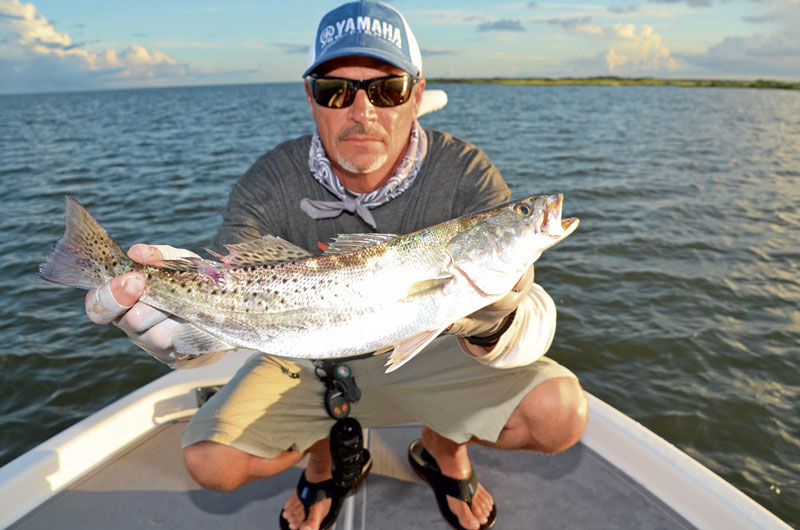
Terrebonne treasures
Terrebonne means “good land” or “good earth” in French. When talking about the Terrebonne Estuary in Louisiana, perhaps it should be renamed bonne eau for “good water” or maybe even bonne pêcheait for “good fishing.” In this part of the world, it helps to understand a little French.
Part of the Barataria-Terrebonne National Estuary between the Mississippi and Atchafalaya Rivers, the Terrebonne Basin contains numerous lakes, bays, ponds and bayous. Anglers quickly recognize the names of larger waters like Terrebonne Bay, Timbalier Bay, Caillou Bay, Lake Pelto, Lake Barre, Lake Felicity and Lake Raccourci. Together, they form a massive open water system surrounded by more than 500,000 acres of marshland.
“I remember years ago, when the lakes and bays were somewhat separated,” said Kip Plaisance (985-637-7251, fishtidewater.com), who guides with his son Max for Plaisance’s Tidewater Charters. “Now, they all run together between Port Fourchon and Cocodrie.”
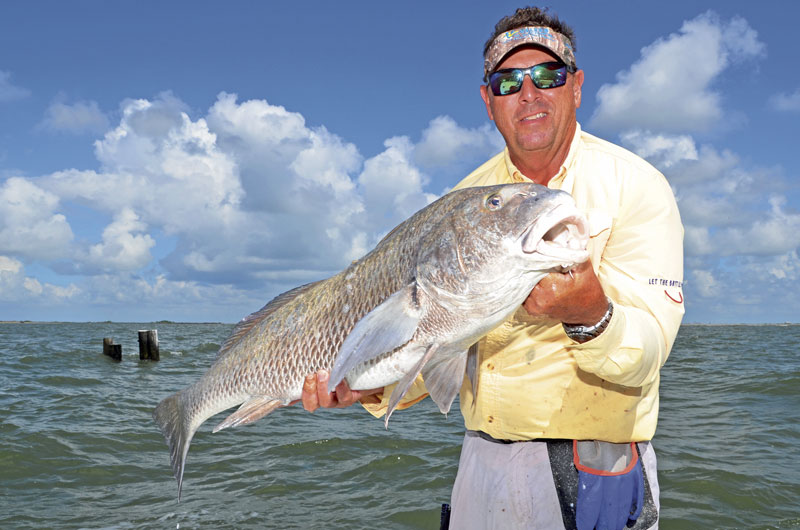
Several uninhabited barrier islands separate the estuary from the Gulf. Last Island, or Isles Dernières, once stretched about 25 miles across the southern part of Terrebonne and Caillou Bays. A small village and beach resort once existed on Last Island until a powerful hurricane cut the island in half, hence the use of the plural Isles now. Battered by hurricanes, many islands now exist only as outcroppings, sandbars or reefs. Others disappeared entirely except for forgotten names on old maps.
“We lost numerous islands over the years from erosion,” Plaisance explained. “People who know where those islands used to be can still catch fish around them.”
The marshes, bays and waters surrounding the islands produce outstanding action for speckled trout and other fish. Sheepshead hang around petroleum platforms, shell reefs and other hard structures. Bull reds and large black drum prowl the bays closer to the gulf. In the marshes, anglers catch “slot” reds, flounder and many other species.
“On a calm day, we cruise the beaches by Last Island or Timbalier Island and see a lot of redfish,” said Tommy Pellegrin of Custom Charters (985-851-3304, www.customchartersllc.com) in Houma. “When big redfish gather in schools, they eat anything. During the summer, all the larger oil production platforms hold lots of bait so that’s where big predators want to be.”
Some boats head offshore from Dulac, Chauvin, Cocodrie, Fourchon and Leeville. Coco Marina, (985-594-6626, cocomarina.com) in Cocodrie offers lodging, a store, restaurant, entertainment and other facilities closest to the gulf. Many large fishing events run out of Coco Marina each year. Houma offers a variety of accommodations, facilities, food and entertainment options. For information, see explorehouma.com.
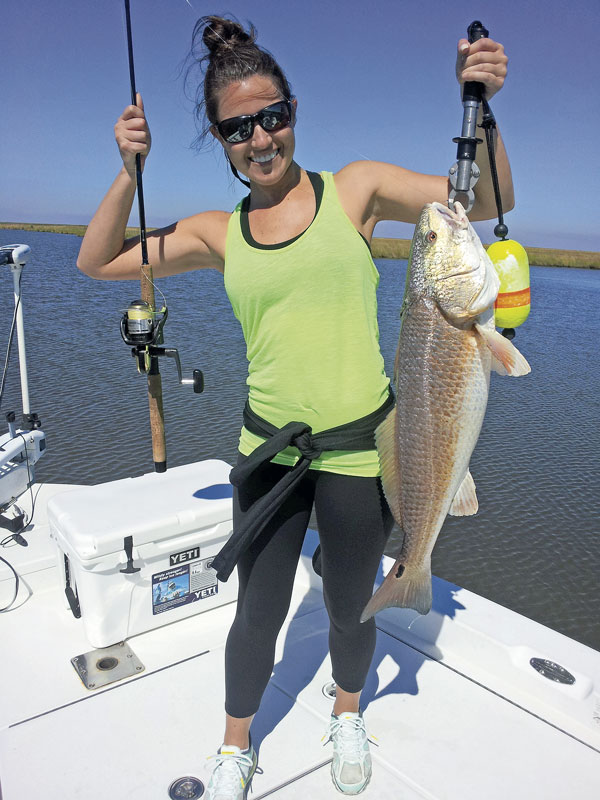
Atchafalaya Delta delights
Situated between Calcasieu Lake and the Terrebonne-Barataria system, the Atchafalaya River delta region tends to get overlooked, but these bays and marshes can provide great fishing for multiple species.
“This area is a hidden gem,” said Troy Nash with South Louisiana Redfishing (337-412-5950, www.southlouisianaredfishing.com). “We have good fishing here, but this area has a much different environment than other places because we don’t have as much broken marshes. We have a lot of open water with many little bayous feeding into them.”
The Atchafalaya River is often considered the second Mississippi River Delta. While much of coastal Louisiana loses wetlands at an astonishing rate, the Atchafalaya River Delta takes 30 percent of the nutrients, silt and flow from the Mississippi, creating a vibrant delta system.
The original Atchafalaya River channel pours into Atchafalaya Bay. The manmade Wax Lake Outlet flows into East Cote Blanche Bay. Vermilion Bay, West Cote Blanche Bay and others merge into essentially one enormous bay. Cypremort Point divides West Cote Blanche Bay and Vermilion Bay. All provide good fishing.
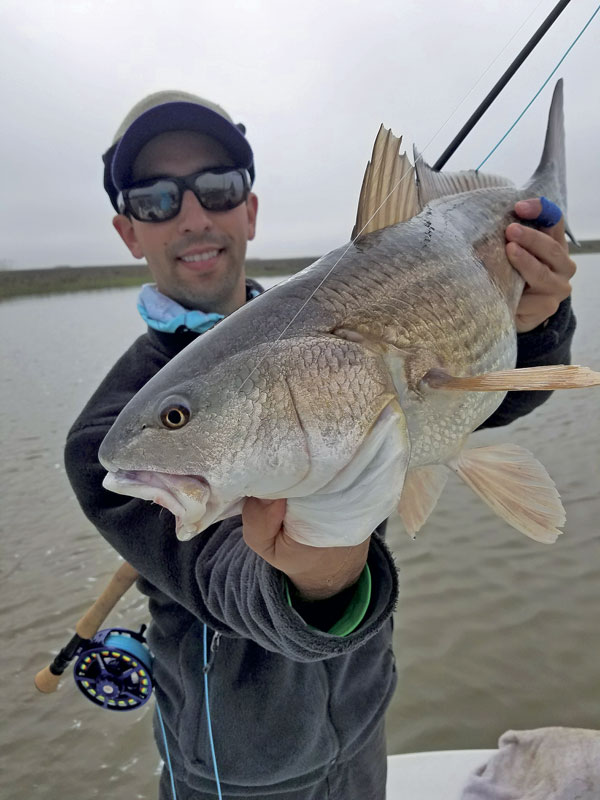
“Looking at the area as a whole, it looks like one giant bay, but the areas are separate and different,” Nash said. “One area might hold more salt water at certain times than other areas. Anytime the river is falling, the salt water comes into the bays. When the river gauge at Butte La Rose is nine feet or less, that’s an excellent time to fish the bays. Sometimes, we get saltwater all the way up into Weeks Bay.”
Fresh water pouring into the bays from the Atchafalaya River dictate salinity levels. During high water periods, the incredible river flow turns everything brown. Saltwater fish like trout move farther south to find more brine. Redfish and flounder can survive in fresher systems so the muddy water doesn’t bother them as much.
When fishing gets tough in the bays, Nash goes to Marsh Island for redfish. The 65,000-acre preserve dominates the southwestern portion of Vermilion Bay. Southwest Pass runs between the mainland of Vermilion Parish and the island.
In late spring and summer, trout move offshore and hang around shell beds. Oil companies removed many structures in recent years, but considerable debris remains providing reefs for fish. Summer, anglers sometimes spot tripletail or cobia under floating vegetation or debris. Anglers also get a good Spanish mackerel run in the warmer months.
Marina facilities at Cypremort Point allow anglers to venture offshore to fish for snapper, cobia and other species. For food and lodging, go to Abbeville, New Iberia or Lafayette. Just north of Vermilion Bay, visit Avery Island. Tour the Tabasco factory and the gardens. See www.tabasco.com/visit-avery-island.
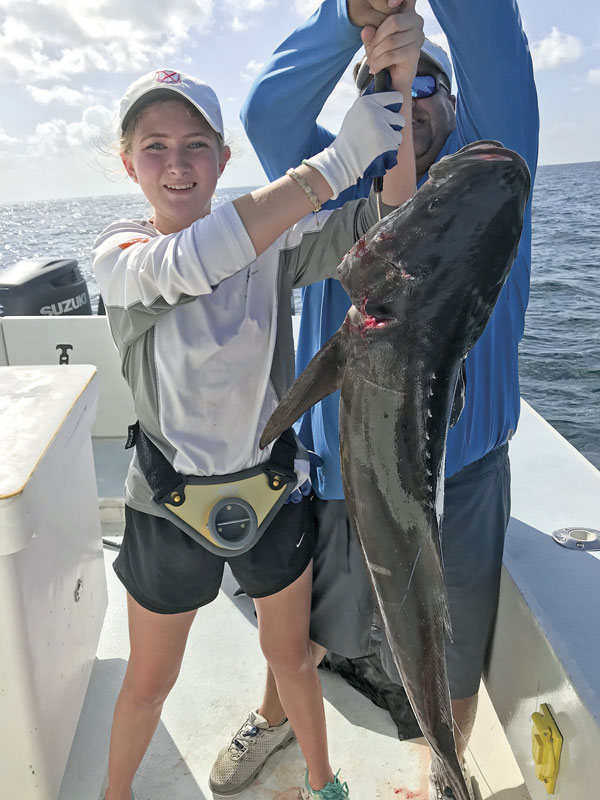
Productive Pecan Island
One of the most remote and least populated parts of the state, the area between Calcasieu Lake and Vermilion Bay in Cameron and Vermilion parishes contains mostly agricultural lands, pastures and marshes. But the Gulf Intracoastal Waterway bisects the area.
Several large, shallow lakes, including White Lake and Grand Lake pockmark the area, running mostly fresh with some salinity. The 72,000-acre White Lake Wetlands Conservation Area just north of Pecan Island offers limited access for fishing. Lacassine National Wildlife Refuge near Grand Lake occupies about 35,000 acres. Both of these areas offer magnificent wildlife photography opportunities.
The Mermentau River runs through the area and flows into Grand Lake before hitting the Gulf of Mexico south of Creole. Lacassine Bayou flows into Lake Misere, which connects to Grand Lake. The river, bayous and lakes run mostly fresh, but saltwater anglers fish the brackish river delta marshes, the beaches, jetties and Gulf of Mexico. Anglers also fish the Freshwater City area.
Rockefeller Wildlife Refuge borders the Gulf of Mexico for 26.5 miles between Grand Chenier and Pecan Island. The state acquired the property in 1919. It covers about 71,000 acres and serves as an outdoors laboratory for wildlife and ecological research, but it also offers some fishing, bird watching and photography opportunities by permit.
Fishing off the banks along canals in the refuge for redfish, speckled trout, drum, flounder and other species is popular and so is catching crab and shrimp. Several boat launches are available.The refuge closes to the public from Dec. 1 to March 1 each year. For refuge rules, see www.wlf.louisiana.gov/page/rockefeller-wildlife-refuge.
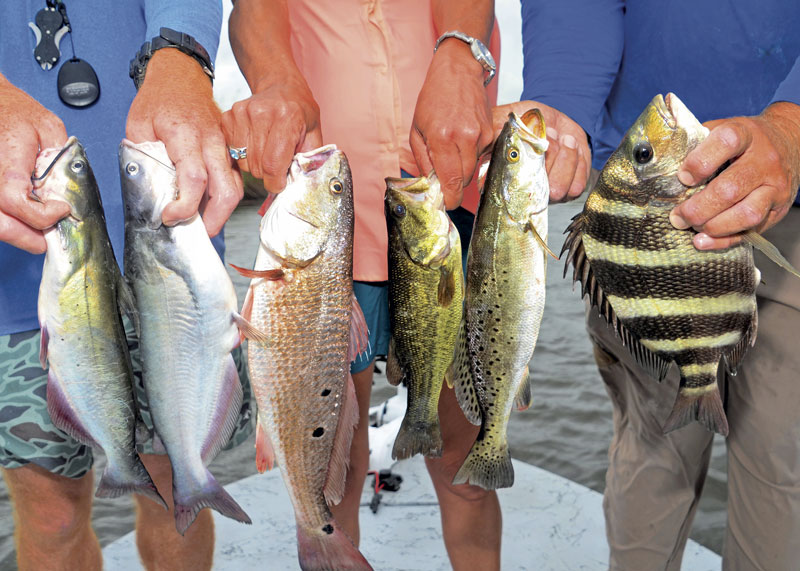
Sabine-Calcasieu expanse
Calcasieu Lake, a 50,000-acre shallow system, anchors the Calcasieu Estuary. Known locally as Big Lake, it offers some of the best trophy speckled trout fishing in the state. The Calcasieu Ship Channel runs 40 miles from Lake Charles to the Gulf of Mexico, touching Big Lake and other small lakes and marshy bayous in the fertile estuary.
On the east side of Big Lake, extensive fresh to brackish marshes south of the Gulf Intracoastal Waterway offer great fishing for redfish, flounder and other species. Weirs block where several bayous enter Big Lake. Even when closed, the weir areas still offer great fishing, particularly on a falling tide. The East Cove Unit of Cameron Prairie National Wildlife Refuge conserves 14,927 acres of wetlands at the southeast corner of Big Lake.
To the west, Sabine Lake covers about 59,700 acres on the Louisiana-Texas line. Sabine Lake connects to the Gulf of Mexico through Sabine Pass and produces giant trout and delivered the Texas state record flounder at 13 pounds.
Between the two lakes, anglers fish a bountiful marsh for multiple fresh and salty species. The Sabine NWR conserves 125,000 acres of these marshes. People can also fish and crab along Highway 27, which runs through the refuge. A popular area for surf fishing is at Holly Beach and other beaches along the Cameron Parish coastline.
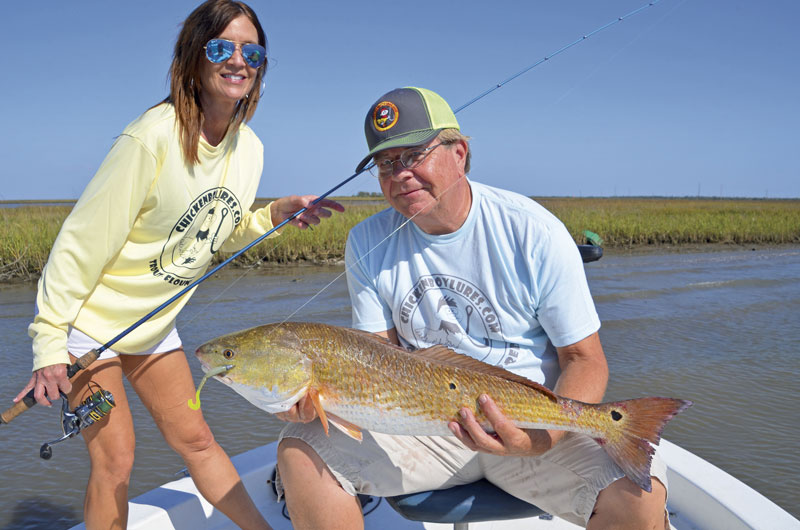
“Most people know Big Lake for trout, but we also fish the marshes and bayous between Big Lake and Sabine Lake,” advised Tom Adams, Jr. of Fishing Tom Guide Service, (318-675-9114, www.fishingtom.net) of Sulphur. “We routinely catch both saltwater and freshwater species in the marshes. We’ve had days where we caught 15 or more species.”
Marinas on both sides of Big Lake provide access. People can also head out into the gulf to fish for Spanish mackerel, tripletail, red snapper and other fish. At the southern end of the Calcasieu Estuary, visitors are thrilled when they spot Pinky, the famous pink dolphin.
Accommodations abound in the Lake Charles area. Many fishing guides offer full service with lodging and food included. If fishing isn’t enough of a gamble for you, several casinos operate in the area.
Nature lovers love to walk the Sabine NWR nature trail or navigate the Pintail Wildlife Drive through Cameron Prairie NWR. For a scenic drive, take all or part of the 180-mile Creole Nature Trail All-American Road. Any cast anywhere in either of these sprawling systems could produce giant speckled trout, big redfish, flounder, sheepshead, drum and many other species. For area information, call 337-502-4358 or see www.visitlakecharles.org.


